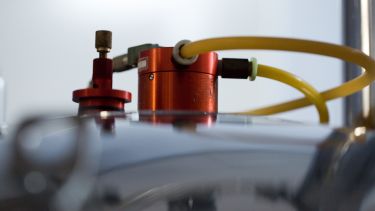Projects
We work on a wide range of projects, often in collaboration with other research teams at the University of Sheffield and other institutions.

Our expertise has a number of applications, including:
- Structure determination for small proteins and the structural characterisation of carbohydrates
- In-depth characterisation of intermolecular interactions, making it a powerful tool for discovering new drugs
- Dynamics measurements to determine how certain processes control biological function, such as the folding of proteins, intermolecular signalling and biological catalysis
- Industrial biotechnology to test the production of chemicals from bio-organisms via high throughput
Below are some examples of what we've been working on recently.
Phosphoryl transfer
We are investigating how enzymes catalyse the transfer of phosphoryl groups, for example in kinases. The projects make extensive use of metal fluorides such as MgF3- and AlF4- as mimics of the transition state, or BeF3- as a mimic of the ground state. We have been investigating structural and dynamic properties, in collaboration with a crystallography group in Grenoble, and quantum chemistry in the USA.
Carbohydrates
TCell surface polysaccharides are an integral component of the bacterial cell wall, essential for structural integrity and often conferring virulence. These large polysaccharides are structurally challenging as they are too flexible in solution for x-ray crystallography or cryo-EM. The only way to address this is an integrated NMR and mass spectrometry approach combining an array of 2D NMR techniques with MS.
Protein structure / function
We are studying the structures of several bacterial carbohydrate binding domains, Las-17 (an actin bundling protein) and their interactions with substrates and effectors, in an effort to understand their functions. In some cases this also includes looking at internal dynamics of the proteins.
Amyloid
We are studying several proteins that cause amyloid disease, with a focus on A-beta (responsible for Alzheimer's), but also including cystatins and transthyretin. We are also continuing a long-standing project on prion protein.
DNA complexes with Ruthenium-based ligands
In collaboration with Professor Jim Thomas in Chemistry, we are looking at interactions between a range of ruthenium-based aromatic ligands and both B-DNA and quadruplex DNA, with the aim of improving the specificity of binding.
Metabolomics
We are studying how the metabolome of E. coli changes in response to changes in oxygen levels. This is giving an interesting insight into how E. coli maintains internal homeostasis.
Phosphate metabolism in plants
With colleagues in Animal and Plant Sciences, we are using 31P NMR to see how plants take up and metabolise phosphorus from the soil.
Hydrogen bonding
We are developing tools to measure hydrogen bonding and salt bridges in proteins, in order to better understand how these interactions influence protein structure, focussing on lysine and arginine sidechains.
Pressure
We are investigating the effects on hydrostatic pressure (up to 2.5 kbar) on proteins and DNA, and using them to study minor conformations and internal dynamics. In a related study, we are developing Rheo-NMR to study the effects of laminar flow on proteins, such as precipitation and orientation.
Intrinsically disordered proteins
We are studying SH2B1, an adaptor downstream of the leptin and insulin receptors, which contains three domains (dimerisation, PH and SH2) and a lot of intrinsicaly disordered sequence. We are studying the physical and functional interactions between these parts.
Industrial biotechnology
Production of chemicals using microorganisms is often limited by the target compounds inhibiting the biocatalyst, which limits the concentration that can be made. We are working to design biocatalysts that are more tolerant to industrially important chemicals. NMR is being used to measure the concentration of the target chemicals made by the improved biocatalysts to identify superior production strains.
Nucleic acids
We investigate the structure and dynamics of nucleic acid constructs and the influence of salts and protein binding parters thereupon. Using 13C, 15N-labelled DNA and/or RNA constructs, the base pair hydrogen bonding patterns, 3D structure and conformational ensemble of the system can deduced. In particular, we seek to better describe the conformational ensemble of discontinuous two-way DNA junctions to understand how the intrinsic dynamics of DNA substrates of 5'-nuclease superfamily members contributes to its recognition in vitro.
